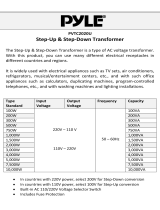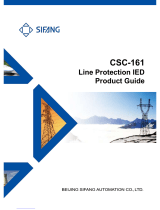
1. Application
RET670 provides fast and selective
protection, monitoring and control for two-
and three-winding transformers,
autotransformers, generator-transformer units
and shunt reactors. The transformer IED is
designed to operate correctly over a wide
frequency range in order to accommodate
power system frequency variations during
disturbances and generator start-up and shut-
down.
A very fast differential protection function,
with automatic CT ratio matching and vector
group compensation, makes this IED the
ideal solution even for the most demanding
applications. RET670 has very low
requirements on the main CTs, no
interposing CTs are required. It is suitable for
differential applications with multi-breaker
arrangements with up to six restraint CT
inputs. The differential protection function is
provided with 2nd harmonic and wave-block
restraint features to avoid tripping for
magnetizing inrush, and 5th harmonic
restraint to avoid tripping for overexcitation.
The differential function offers a high
sensitivity for low-level internal faults.
RET670 unique and innovative sensitive
differential protection feature, based on well-
known theory of symmetrical components
provide best possible coverage for winding
internal turn-to-turn faults.
Low impedance restricted earth-fault
protection functions are available as
complimentary sensitive and fast main
protection against winding earth faults. This
function includes a directional zero-sequence
current criterion for additional security.
Additionally a high impedance differential
function is available. It can be used as
restricted earth fault or, as three functions are
included, also as differential protection on
autotransformers, as differential protection
for a tertiary connected reactor, as T-
differential protection for the transformer
feeder in a mesh-corner or ring arrangement,
as tertiary bus protection and so on.
Tripping from Pressure relief / Buchholz and
temperature devices can be done through the
transformer IED where pulsing, lock-out
contact output and so on, is performed. The
binary inputs are heavily stabilized against
disturbance to prevent incorrect operations at
for example, dc system capacitive discharges
or dc earth faults.
Distance protection functionality for phase-to-
phase and/or phase-to-earth faults is available
as back-up protection for faults within the
transformer and in the connected power
system.
Versatile phase, earth, positive and zero
sequence overcurrent functions, which can
optionally be made directional and/or voltage
controlled, provide further alternative backup
protection. Thermal overload with two time-
constants, volts per hertz, over/under voltage
and over/under frequency protection
functions are also available.
Built-in disturbance and event recorder
provides valuable data to the user about
status and operation for post-fault
disturbance analysis.
Breaker failure protection for each
transformer breaker allows high speed back-
up tripping of surrounding breakers.
The transformer IED can also be provided
with a full control and interlocking
functionality including Synchrocheck function
to allow integration of the main and/or a
local back-up control.
The advanced logic capability, where user
logic is prepared with a graphical tool, allows
special applications such as automatic
opening of disconnectors in multi-breaker
arrangements, closing of breaker rings, load
transfer logic and so on. The graphical
Transformer protection RET670 1MRK 504 091-BEN B
Pre-configured
Product version: 1.1
Issued: June 2010
Pre-configured Revision: B
ABB 3






















